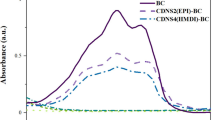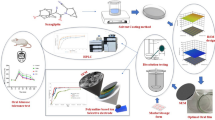Abstract
Naringin, a dietary flavonoid of citrus fruits, was encapsulated in biodegradable proteins of zein/casein biopolymers for its enhanced functional properties. The formulation conditions for the synthesis of colloidal particles were optimised by Response surface Methodology (RSM) and the levels were at zein/sodium casein ratio 1.75, pH 9 and naringin 8.7 mg/mL. The optimised nanoparticles showed the mean particle size of 234 nm, zeta potential of − 28.2 mV and a narrow size distribution with the encapsulation efficiency of 71 ± 2%. The physiochemical characteristics of the nanoparticles were analysed by SEM, FTIR, AFM, XRD and DSC techniques. The release kinetics study demonstrated that the release of naringin from the nanoparticles was pH dependent and had an appreciable amount of in vitro bioaccessibility. In 3T3-L1 cell culture study, the encapsulated naringin showed higher anti-adipogenic activity than the unencapsulated molecule by lowering the intracellular lipid accumulation. Further, the toxicity studies in Caco-2 cells indicated that the nanoparticles were free of any adverse effects. Collectively, naringin encapsulated colloidal formulation can be a promising delivery system in functional foods for varied health benefits.







Similar content being viewed by others
References
J. Peterson, G. Beecher, S. Bhagwat, J. Dwyer, S. Gebhardt, D. Haytowitz, and J. Holden (2006). Flavanones in grapefruit, lemons, and limes: A compilation and review of the data from the analytical literature. J. Food Compos. Anal. S74-S80.
[2] G.C. Jagetia, and V. Lalnuntluangi (2016). The citrus flavanone naringin enhances antioxidant status in the albino rat liver treated with doxorubicin. Biochem. Mol. Biol. J. 2(2), 1-9.
[3] Y. Chtourou, B. Aouey, S. Aroui, M. Kebieche, and H. Fetoui (2016). Anti-apoptotic and anti-inflammatory effects of naringin on cisplatin-induced renal injury in the rat. Chem. Biol. Interact. 243, 1-9.
[4] H. Cao, J. Liu, P. Shen, J. Cai, Y. Han, K. Zhu, Y. Fu, N. Zhang, Z. Zhang, and Y. Cao (2018). Protective effect of naringin on DSS-Induced ulcerative colitis in mice, J. Agric. Food Chem. 66(50), 13133-13140.
[5] A.N. Murunga, D.O. Miruka, C. Driver, F.S. Nkomo, S. Cobongela, and P.M.O. Owira (2016). Grapefruit derived flavonoid naringin improves ketoacidosis and lipid peroxidation in Type 1 diabetes rat model. PLoS One, 11(4), e0153241.
[6] B. Ben-Azu, E.E. Nwoke, A.O. Aderibigbea, I.A. Omogbiyaa, A.M. Ajayia, E.T. Olonodea, S. Umukoroa, and E.O. Iwalewa (2019). Possible neuroprotective mechanisms of action involved in the neurobehavioral property of naringin in mice. Biomed. Pharmacother. 109, 536-546.
[7] J. Cui, G. Wang, A.D. Kandhare, A.A. Mukherjee-Kandhare, and S.L. Bodhankar (2018). Neuroprotective effect of naringin, a flavone glycoside in quinolinic acid-induced neurotoxicity, Possible role of PPAR-γ, Bax/Bcl-2, and caspase-3. Food Chem. Toxicol. 121, 95-108.
[8] X. Wu, Z. Huang, J. Liu, Y. Chen, H. Huang, Y. He, D. Li, L. Zhang, Z. Du, K. Zhang, S. Goodin, and X. Zheng (2019). Effects and mechanism of inhibition of naringin in combination with atorvastatin on prostate cancer cells in vitro and in vivo. Phytochem. Lett. 32,168-176.
[9] S.L. Hsiu, T.Y. Huang, Y.C. Hou, D.H. Chin, and P.D. Chao (2002). Comparison of metabolic pharmacokinetics of naringin and naringenin in rabbits. Life Sci, 70 (13), 1481-1489.
[10] M. Liu, W. Zou, C.Yang, Peng, and W. Su (2012). Metabolism and excretion studies of oral administered naringin, a putative antitussive, in rats and dogs. Biopharm. Drug. Dispos. 33(3), 123-134.
[11] T. Chen, W. Su, Z. Yan, X. Zeng, W. Peng, L. Gan, Y. Zhang, and H. Yao (2018). Identification of naringhin metabolites mediated by human intestinal microbes with stable isotope-labeling method and UFLC-Q-TOF-MS/MS. J. Pharm. Biomed. Anal. 161, 262-272.
[12] E.A. Mohamed, R.M. Abu Hashim, A.A.A. Yusif, A.R. Shaaban, M.F. El-Sheakh, M.F. Hamed, and F.A.E. Badria (2018). Polymeric micelles for potentiated antiulcer and anticancer activities of naringin. Int. J. Nanomedicine. 13, 1009-1027.
[13] D.A. Pai, V.R. Vangala, J.W. Ng, W.K. Ng, and R.B.H. Tan (2015). Resistant maltodextrin as a shell material for encapsulation of naringin: Production and physicochemical characterization. J. Food Eng. 161, 68-74.
[14] M. Pleguezuelos-Villa, S. Mir-Palomo, O. Díez-Sales, M.A.O V. Buso, A.R. Sauri, and A. Nácher (2018). A novel ultradeformable liposomes of Naringin for anti-inflammatory therapy. Colloids Surf. B Biointerfaces. 162, 265-270.
[15] M.R. Lauro, F. De Simone, F. Sansone, P. Iannelli, and R.P. Aquino (2007). Preparations and release characteristics of naringin and naringenin gastro-resistant microparticles by spray-drying. J. Drug Deliv. Sci. Technol. 17, 119-124.
[16] T. Feng, K. Wang, F. Liu, R. Ye, X. Zhu, H. Zhuang, and Z. Xu (2017). Structural characterization and bioavailability of ternary nanoparticles consisting of amylose, -linoleic acid and-lactoglobulincomplexed with naringin. Int. J. Biol. Macromol. 99, 365-374.
[17] K. Ghosal, D. Ghosh, and S.K. Das (2018). Preparation and evaluation of naringin-loaded polycaprolactone microspheres based oral suspension using Box-Behnken design. J. Mol. Liq. 256, 49-57.
[18] A. Shpigelman, Y. Shoham, G. Israeli-Lev, and Y.D Livney (2014). b-Lactoglobulinenaringenin complexes, nano-vehicles for the delivery of a hydrophobic nutraceutical. Food Hydrocoll. 40, 214-224.
[19] A.O. Elzoghby, W.M. Samy, and N.A. Elgindy (2012). Protein-based nanocarriers as promising drug and gene delivery systems. J. Control. Release. 161(1), 38-49.
[20] A.R. Patel, E.C.M. Bouwens, and K.P. Velikov (2010). Sodium Caseinate Stabilized Zein Colloidal Particles. J. Agric. Food Chem. 58 (23), 12497-12503.
[21] Y. Luo, Z. Teng, T.T. Wang, and Q. Wang (2013). Cellular uptake and transport of zein nanoparticles: effects of sodium caseinate. J. Agric. Food Chem. 61(31), 7621-7629.
[22] A.R. Patel, P.C.M. Heussen, J. Hazekamp, E. Drost, and K.P. Velikov (2012). Quercetin loaded biopolymeric colloidal particles prepared by simultaneous precipitation of quercetin with hydrophobic protein in aqueous medium. Food Chem. 133(2), 423-429.
[23] S. Dahiya, R. Rani, D. Dhingra, S. Kumar, and N. Dilbaghi (2018). Conjugation of epigallocatechingallate and piperine into a zeinnanocarrier: implication on antioxidant and anticancer potential, Adv. Nat. Sci. Nanosci. Nanotechnol. 9(3), 035011.
[24] Q. Liu, Y. Jing, C.Han, H. Zhang, and Y. Tian (2019). Encapsulation of curcumin in zein/ caseinate/sodium alginate nanoparticles with improved physicochemical and controlled release properties, Food Hydrocoll. 93, 432-442.
[25] P. Ji, T. Yu, Y. Liu, J. Jiang, J. Xu, Y. Zhao, Y. Hao, Y. Qiu, W. Zhao, and C. Wu (2016). Naringenin-loaded solid lipid nanoparticles: preparation, controlled delivery, cellular uptake, and pulmonary pharmacokinetics, Drug Des. Devel. Ther. 10, 911-925.
[26] N. Ilaiyaraja, D. Aishwarya, and K. Farhath (2015). Chlorogenic acid loaded chitosan nanoparticles with sustained release property, retained antioxidant activity and enhanced bioavailability. Asian J. Pharm. Sci.10, 203-211.
[27] Y. Carmona-Jiménez, M.V. García-Moreno, J.M. Igartuburu, and C.G. Garcia Barroso (2014). Simplification of the DPPH assay for estimating the antioxidant activity of wine and wine by-products. Food Chem. 165, 198-204.
H. Jayan, M.M. Leena S.K.S. Sundari, J.A. Moses, and C. Anandharamakrishnan, Improvement of bioavailability for resveratrol through encapsulation in zein using electrospraying technique. J. Funct. Foods. 57, 417–424.
[29] S. Zhang, and Y. Han (2018). Preparation, characterisation and antioxidant activities of rutin-loaded zein-sodium caseinate nanoparticles. PLoS One. 13(3), e0194951.
[30] H. Chen, and Q. Zhong (2015). A novel method of preparing stable zein nanoparticle dispersions for encapsulation of peppermint oil. Food Hydrocoll. 43, 593-602.
[31] D. Zheng, and Q.F. Zhang (2019). Bioavailability enhancement of astilbin in rat through zein-caseinate nanoparticles. J. Agric. Food Chem. 67, 5746-5753.
[32] Y. Wu, Y. Luo, and Q. Wang (2012). Antioxidant and antimicrobial properties of essential oils encapsulated in zein nanoparticles prepared by liquid–liquid dispersion method. LWT - Food Sci. Technol. 48, 283-290.
[33] C. Chang, T. Wang, Q. Hu, and Y. Luo (2017). Caseinate-zein-polysaccharide complex nanoparticles as potential oral delivery vehicles for curcumin: Effect of polysaccharide type and chemical cross-linking. Food Hydrocoll. 72, 254-262.
[34] J. Xue, Y. Zhang, G. Huang, J. Liu, M. Slavin, and L. Yu (2018). Zein-caseinate composite nanoparticles for bioactive delivery using curcumin as a probe compound. Food Hydrocoll. 83, 25-35.
[35] F. Zhang, M.A. Khan, H. Cheng, and L. Liang (2019). Co-encapsulation of α-tocopherol and resveratrol within zein nanoparticles: Impact on antioxidant activity and stability. J. Food Eng. 247, 9-18.
[36] H. Li, Y. Xua, X. Sun, S. Wang, J. Wang, J. Zhud, D. Wang, and L. Zhao (2018). Stability, bioactivity, and bioaccessibility of fucoxanthin in zein-caseinate composite nanoparticles fabricated at neutral pH by antisolvent precipitation. Food Hydrocoll. 84, 379-388.
[37] P. Hurtado-López, and S. Murdan (2005). Formulation and characterisation of zein microspheres as delivery vehicles. J. Drug Deliv. Sci. Technol. 15(4), 267-272.
Y. Luo, B. Zhang, M. Whent, L. Yu, and Q. Wang (2011). Preparation and characterization of zein/chitosan complex for encapsulation of α-tocopherol, and its in vitro controlled release study. Colloids Surf.B Biointerfaces. 85(2), 145–152.
[39] M. Wang, Y. Fu, G. Chen, Y. Shi, X. Li, H. Zhang, and Y. Shen (2018). Fabrication and characterization of carboxymethyl chitosan and tea polyphenols coating on zein nanoparticles to encapsulate b-carotene by anti-solvent precipitation method. Food Hydrocoll. 77, 577-587.
[40] Y. Chen, Z. Zhenlei, X. Guobin, X. Fan, C. Chun, and Z. Ying (2020). Fabrication and characterization of zein/lactoferrin composite nanoparticles for encapsulating 7, 8-dihydroxyflavone: Enhancement of stability, water solubility and bioaccessibility. Int. J. Biol. Macromol. 146, 179-192.
[41] F. Dong, X. Dong, L. Zhou, H. Xiao, P.Y. Ho, M.S. Wong, and Y. Wang (2016). Doxorubicin-loaded biodegradable self-assembly zein nanoparticle and its anti-cancer effect: Preparation, in vitro evaluation, and cellular uptake. Colloids Surf B Biointerfaces. 140, 324-331.
[42] M. Bacanli, A.A. Başaran, and N. Başaran (2015). The antioxidant and anti-genotoxic properties of citrus phenolics limonene and naringin. Food Chem. Toxicol. 81,160-170.
[43] R. Roghini, and K. Vijayalakshmi (2018). Free radical scavenging activity of ethanolic extract of citrus paradisi and naringin -An In vitro Study. Int. J. Pharmacogn. Phytochem. Res. 10(1), 11-16.
[44] S.H. Bok, Y.W. YW, K.H. Bae, T.S. Jeong, Y.K. Kwon, and Y.B. Park (2000). Effects of naringin and lovastatin on plasma and hepatic lipids in high-fat and high-cholesterol fed rats. Nutrition Res. 20, 1007-15.
[45] X. Guo, J. Liu, S. Cai, O. Wang, and B. Ji (2016). Synergistic interactions of apigenin, naringin, quercetin and emodin on inhibition of 3T3-L1 preadipocyte differentiation and pancreas lipase activity. Obesity Res. Clinic. Practice. 10, 327-339.
Acknowledgments
This work was supported financially by the Defence Research and Development Organisation (DRDO), New Delhi
Author information
Authors and Affiliations
Corresponding author
Ethics declarations
Conflict of Interest
The authors of the manuscript have no conflict of interest.
Additional information
Publisher's Note
Springer Nature remains neutral with regard to jurisdictional claims in published maps and institutional affiliations.
Electronic supplementary material
Below is the link to the electronic supplementary material.
Rights and permissions
About this article
Cite this article
Nallamuthu, I., Ponnusamy, V., Smruthi, M.R. et al. Formulation of Naringin Encapsulation in Zein/Caseinate Biopolymers and its Anti-adipogenic Activity in 3T3-L1 Pre-adipocytes. J Clust Sci 32, 1649–1662 (2021). https://doi.org/10.1007/s10876-020-01909-1
Received:
Accepted:
Published:
Issue Date:
DOI: https://doi.org/10.1007/s10876-020-01909-1




